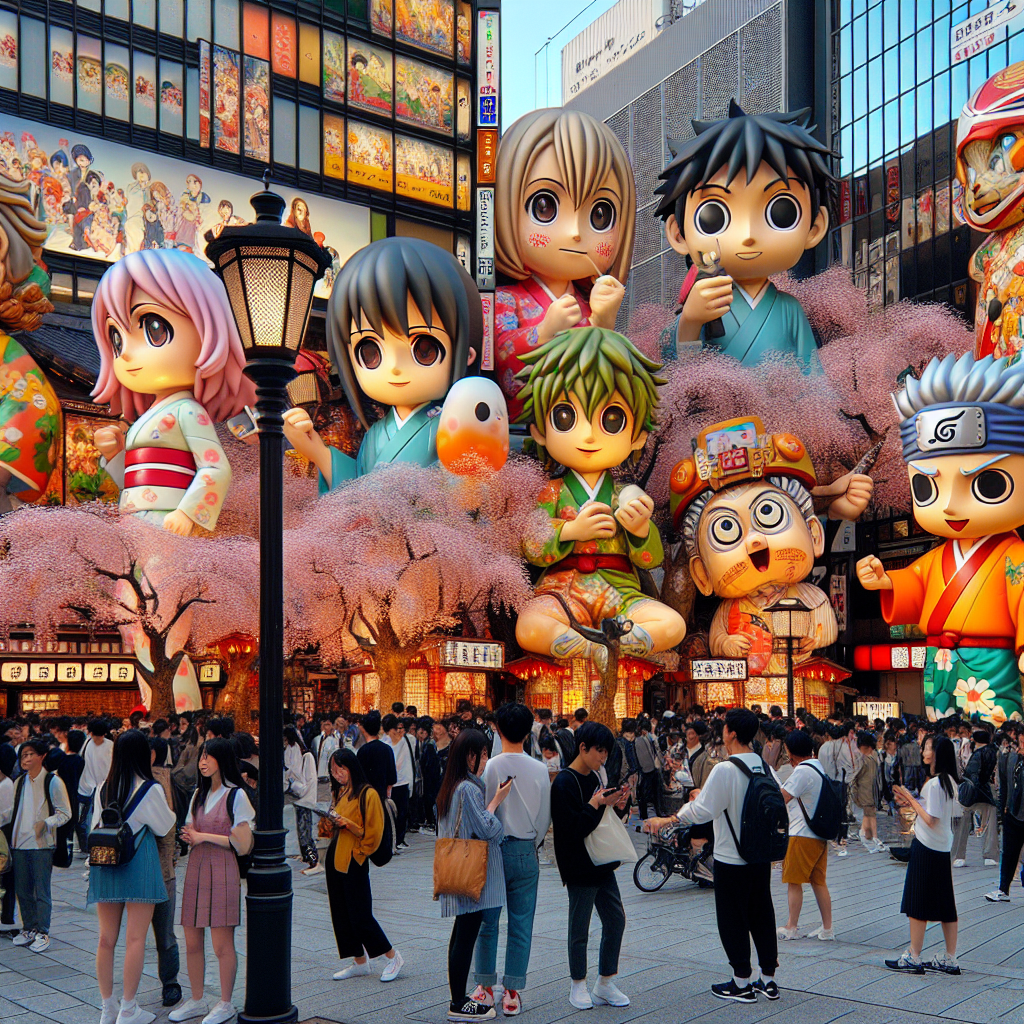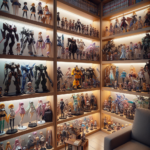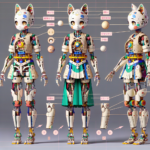
Unlock the Magic: A Tour of Japanese Anime Statues in Public Spaces
Imagine walking through the bustling streets of Japan, turning a corner, and coming face-to-face with a towering statue of your favorite anime character. It’s not just fantasy—it’s a reality in many Japanese cities. Public spaces across the country celebrate the rich culture of anime with life-size statues, offering fans a unique way to connect with their beloved characters and the stories they come from.
Article-at-a-Glance: Exploring Japanese Culture Through Anime Statues
- Discover how anime statues in public spaces pay tribute to Japan’s cultural phenomenon.
- Learn about the impact these statues have on tourism and local pride.
- Uncover the stories behind some of Japan’s most iconic anime statues.
- Find out how these statues have become cultural icons in their own right.
- Get tips on planning your own anime statue tour across Japan.
The Allure of Anime in the Open Air
There’s something magical about encountering a piece of your favorite anime in the real world. These statues aren’t just impressive in size; they’re crafted with such detail and care that they seem to leap out of the screen and into our world. Whether it’s a quiet moment with a life-size Totoro at a bus stop or an action-packed pose of Goku ready to unleash a Kamehameha, these statues create a bridge between the animated adventures and our everyday lives.
Statues, Tourism, and Cultural Pride
These anime statues do more than just decorate the landscape; they draw visitors from all over the globe, eager to experience a piece of their favorite anime in person. This influx of tourism not only boosts the local economy but also instills a sense of pride among residents. Communities often rally around these statues, celebrating the global impact of their cultural exports and the joy they bring to fans worldwide.
Anime Statues as Cultural Icons
It’s not just about size or spectacle; these statues have become cultural icons that represent the heart and soul of anime. They stand as monuments to the creativity and passion that go into anime production, embodying the stories and characters that have shaped the genre. As you stand before these statues, you’re not just seeing a character; you’re witnessing a piece of Japan’s cultural legacy.
Statues that Define Regions: Stories Behind the Sculptures
Each statue has a story, often tied to the region where it stands. For example, the Gundam statue in Odaiba is more than a tribute to the beloved series; it’s a symbol of innovation and technology, reflecting the futuristic spirit of the area. Meanwhile, the bronze statues of the Straw Hat Pirates in Kumamoto serve as a beacon of hope and resilience, erected to support the region’s recovery after devastating earthquakes.
These stories add depth to the statues, transforming them from mere representations of characters into meaningful landmarks that resonate with locals and visitors alike. They’re not just attractions; they’re narratives carved in metal and stone, inviting you to explore the cultural fabric of Japan one statue at a time.
Fusion of Art and Anime: Celebrating Japanese Creativity
Japan’s anime statues are a true fusion of art and pop culture, showcasing the nation’s dedication to creativity and its influence on the global stage. Each statue is a testament to the meticulous artistry that goes into anime production, from initial sketches to the final 3D renderings. They stand as bold expressions of the artists’ vision, bringing two-dimensional characters into our three-dimensional world with stunning accuracy and attention to detail.
Planning Your Pilgrimage: Top Destinations for Anime Statues
Ready to embark on an anime adventure? Japan is dotted with destinations where you can meet your favorite characters in statue form. From the colossal Gundam in Tokyo to the whimsical ‘GeGeGe no Kitaro’ characters in Tottori, there’s a statue for every genre of anime fan. Map out your journey to include stops at Akihabara for a slice of otaku culture, or make your way to the rural towns that celebrate their local anime legends with pride.
The One Piece Effect: Statues Revitalizing Kumamoto
In Kumamoto, the impact of anime statues is felt deeply. After the 2016 earthquakes, the ‘One Piece’ statues became a symbol of the region’s resilience and determination to rebuild. Each statue of Luffy and his crew, donated by creator Eiichiro Oda, who hails from Kumamoto, not only draws fans from across the world but also serves as an enduring reminder of the power of community and the enduring spirit of the beloved series.
Oizumi Anime Gate: Where Anime Legends Live
At the Oizumi Anime Gate, located in Tokyo’s Nerima ward, a hub for anime studios, you’ll be greeted by a lineup of legendary characters from ‘Lupin III’, ‘Astro Boy’, and more. This gateway marks the entrance to a neighborhood steeped in anime history, inviting you to walk the same streets as the creators who brought these iconic characters to life.
The Craft of Collectibles: From Screen to Statue
Collecting anime statues isn’t just a hobby; it’s a way to own a piece of the anime saga. The craft behind each collectible is a meticulous process that involves sculptors, painters, and designers working in tandem to ensure every detail is captured, from the folds in a character’s clothes to the glint in their eyes. These collectibles are more than just memorabilia; they’re works of art that celebrate the legacy of anime.
Bringing Characters to Life: The Process of Creation
The journey from screen to statue is a fascinating one. It begins with the careful selection of a character’s most iconic pose, followed by the sculpting of intricate models. Using a variety of materials, from clay to digital 3D models, artists painstakingly recreate every element of the character. After the model is perfected, it’s cast, detailed, and painted, resulting in a statue that’s ready to take its place in the hearts of fans and the annals of anime history.
Maintaining the Magic: How Public Anime Statues Are Conserved
To ensure these iconic statues withstand the test of time and weather, meticulous care is taken in their maintenance. Regular cleaning schedules, damage inspections, and restorative work are all part of the conservation effort. It’s a behind-the-scenes labor of love that keeps the statues as vibrant and awe-inspiring as the day they were unveiled. The community often plays a role too, with local fans and volunteers pitching in to help preserve these treasured landmarks.
Engaging Activities at Anime Statue Sites
Visiting anime statues isn’t just about taking pictures; it’s an experience that can include a variety of engaging activities. Many statue sites have incorporated interactive elements like augmented reality (AR) apps, which bring the statues to life on your smartphone screen. These experiences deepen the connection between fans and their favorite characters, creating unforgettable memories.
Interacting with Giants: Photo Ops and AR Experiences
Imagine posing for a photo as a giant anime character playfully interacts with you, thanks to the magic of AR technology. These photo ops are not only fun but also shareable, perfect for social media. Fans can battle alongside their heroes or receive a virtual gift from their favorite characters, making the visit to an anime statue a dynamic and modern adventure.
Ramen and Relics: Anime-Themed Eateries and Merchandise Shops
No anime statue visit is complete without a stop at themed eateries and merchandise shops nearby. Fans can enjoy a bowl of ramen inspired by their favorite series or browse through exclusive collectibles that can’t be found anywhere else. These shops often feature limited-edition items, making each purchase a unique addition to any collection.
From Fan to Fanatic: Enhancing Your Anime Statue Collection
For those who wish to bring a piece of the magic home, collecting anime statues offers a tangible way to celebrate and showcase your love for the genre. It’s a hobby that can start with a single figure and grow into a curated collection of cherished characters, each with its own story and significance.
Starting Your Collection: A Beginner’s Guide
Starting an anime statue collection is as simple as choosing a character that resonates with you. From there, consider the size of the statue, the level of detail, and the manufacturer’s reputation for quality. It’s important to also think about how you’ll display your statues, ensuring they’re protected from dust and sunlight. Begin with one or two pieces and expand as you discover more about the vast world of anime collectibles.
Exclusive Finds: Rare Statues and Where to Spot Them
For the dedicated hunter of anime statues, there’s a thrill in tracking down the rare and elusive. These are the statues that are off the beaten path, often in smaller towns or tucked away in unexpected places. Take, for instance, the ‘Cardcaptor Sakura’ statue in Sakura, Chiba, which stands as a quiet homage to the series. Or the ‘Detective Conan’ statues in Hokuei, Tottori, the hometown of the manga’s creator. These rare finds are treasures waiting to be discovered, offering a unique connection to the heart of anime’s origins.
Celebrating Anime Through Community Contributions
It’s not just about what these statues represent; it’s about the communities that build and sustain them. Local fans often contribute to the creation and upkeep of these statues, whether through crowdfunding campaigns or volunteer work. This communal effort reflects the shared passion for anime and the collective desire to honor its impact on culture and art. By visiting these statues, you’re not just seeing a landmark; you’re witnessing the result of a community’s love for anime.
Supporting the Localities: How Your Visits Make a Difference
When you visit a public anime statue, you’re doing more than taking in a sight; you’re supporting the locality. Your presence contributes to the economy, encourages the preservation of cultural landmarks, and validates the efforts of those who maintain these statues. By buying local goods, dining at nearby restaurants, or staying in the area, you’re investing in the community and ensuring that the legacy of anime continues to enrich the lives of those who live there.
Upcoming Projects: What’s Next for Public Anime Statues?
The landscape of public anime statues is ever-evolving. With new series gaining popularity and classic franchises celebrating anniversaries, there are always fresh projects on the horizon. Plans for new statues are often announced at anime conventions or through municipal news, sparking excitement and anticipation among fans. Keep an eye out for announcements, and you might just be among the first to visit the next iconic anime statue.
FAQ: Unveiling Common Queries
Got questions? You’re not alone. Here’s a quick rundown of some common queries fans have when planning their anime statue adventures.
Can you participate in anime events near statues?
Absolutely! Many statue sites host events, especially during series anniversaries or special promotions. These can range from cosplay gatherings to interactive games and challenges. Participation is a fantastic way to immerse yourself in the anime community and create memories that extend beyond a simple visit. Check local event calendars and fan forums for upcoming activities, and don’t miss the chance to join in on the fun.
Are there guided tours for anime statue locations?
Yes, there are guided tours available, especially in areas with a high concentration of anime statues. These tours are designed to provide a comprehensive experience, often led by knowledgeable guides who can share insights about the anime series and the history of the statues. Some tours even offer exclusive access to related attractions or gift shops. To find a tour, check with local tourism offices or search online for anime-themed tour packages.
How can you contribute to preserving these cultural landmarks?
Preserving these cultural landmarks is a community effort, and there are several ways you can contribute. Participating in cleanup days, donating to preservation funds, or even spreading awareness through social media can make a significant impact. Additionally, respecting the statues during your visit by not climbing on them or causing damage ensures they remain intact for future fans to enjoy. Every small action helps maintain these treasures for years to come.
What are some considerations when visiting these public spaces?
When visiting public spaces with anime statues, it’s important to be mindful of the local culture and customs. Always be respectful to the surrounding area and its residents. Keep noise levels down, dispose of trash properly, and follow any posted guidelines. Remember, these statues are often in areas that hold significance for the local community, so treating them with care is a way of showing respect for both the anime and the locale.
Is there a roadmap to all the anime statues in Japan?
While there isn’t an official roadmap that covers every single anime statue in Japan, many fan-created maps and guides are available online. These resources are constantly updated with new installations and can be invaluable for planning your statue-hopping journey. Additionally, local tourism websites often provide information on notable anime landmarks in their region, making it easier to plot your route.
In conclusion, anime statues in public spaces are more than just impressive sculptures; they are a celebration of Japanese culture and a testament to the enduring popularity of anime. They connect fans with their favorite characters in a tangible way and serve as a bridge between the animated world and reality. As you embark on your anime statue pilgrimage, remember that you’re not just witnessing art; you’re participating in a cultural phenomenon that spans generations and continues to inspire. Whether you’re a seasoned collector or a new fan, the journey through Japan’s landscape of anime statues promises to be an unforgettable adventure that deepens your appreciation for the creativity and passion behind this beloved art form.





One response
[…] inch of the YaYa Studio Naruto Sage Mode Statue showcases expert craftsmanship. From the intricate lines of Naruto’s outfit to the precise […]